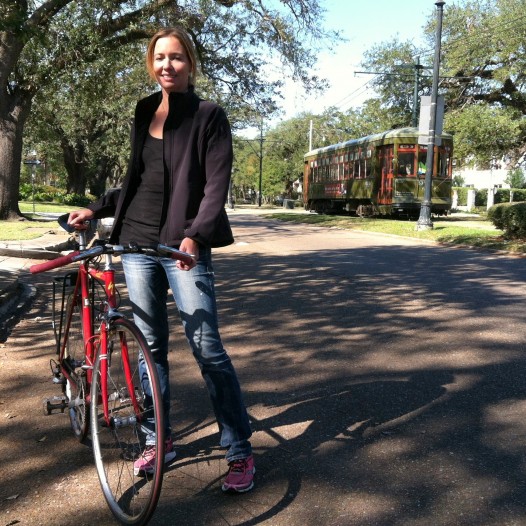
UNO transportation student Emilie Bahr takes a break from writing her thesis to enjoy a bike ride down St. Charles Avenue.
Based on the results of the Great Decatur Street Debate, it is apparent that public opinion about cycling and cycling infrastructure is not apparent enough – not to the Department of Public Works, anyway. Given the events of recent weeks, a survey that “asks about factors that promote and discourage bicycling in New Orleans” seems pretty well timed, no?
Enter Emilie Bahr, a graduate student concentrating in transportation at the UNO Department of Planning and Urban Studies, who has developed a survey that “will improve understanding of bicycling patterns” in New Orleans and plans to use the data collected as part of her thesis for a master’s degree in urban and regional planning.
Bahr’s personal interest in cycling/cycling infrastructure and her new-found calling to study urban planning are relatively recent, though nonetheless significant, developments in the self-described progressive environmentalist’s life.
The 32-year-old Baton Rouge native originally double majored in government and French at the University of Texas, Austin. Upon earning her degrees, however, she had already decided she would rather be a writer. So Bahr headed to Washington D.C., where she interned with the Washington Post and another publication known as the U.N. Wire.
“After about a year [in D.C.],” she said (as many often do), “I really wanted to be in New Orleans.” And, following a brief stint with a newspaper in Thibodeaux, she began writing for CityBusiness, where, she said, “I found myself gravitating toward issues related to community revitalization, transportation and public engagement post-Katrina.”
Bahr continued to cultivate her interest in “how cities work,” and, through her beat coverage at CityBusiness, she began to take note of changes occurring in New Orleans’ urban landscape. In particular, she found that many of the streets getting repaved during the post-Katrina rebuilding process were being re-striped with bike lanes. She even began to notice more, though still not many, bicycle commuters.
Her personal and professional interest in cycling was convincingly piqued, however, while attending a party in the Marigny.
“When I got down there, I noticed bikes everywhere!” she said. “And while I was at the party, I met a guy who worked for the public defender’s office who told me everyone bikes to work there.
“It was at that point that I realized something was happening.” She began to ask herself, she says, “If others are biking, why can’t I?” She also began to contemplate why some parts of the city have higher percentages of bicycle commuters than others.
That intrigue and curiosity led Bahr to pursue her newest passion as a graduate student in the UNO Department of Planning and Urban Studies. She began riding her bike between her Uptown apartment and the UNO Lakefront campus where she attends classes and conducts research.
Indeed, over the course of her studies, she has found that there is significant amount of scientific data out there that supports her observations about the local cycling community.
Perhaps the most arresting information she came across is that New Orleans is the Southeast leader and tied for number 12 in the country in cycling, with 1.8 percent of the population commuting by bicycle, according to the League of American Bicyclists’ 2000-2010 Bike Commuter Statistics for 70 Largest US Cities.
“Yet,” she said, “certain parts of the city such as the Marigny/Bywater or near the old [C.J. Peete] housing projects have much higher rates of bicycle commuting — higher than even that of Portland, Oregon. Others, such as Lakeview, have almost none.”
The disparity in bicycle commuting across the metropolitan area was the fundamental motivation for her research.
As she puts it, “My thesis is looking at the spatial variation in bike commuting across the city in an attempt to understand why certain sections of the city are characterized by booming rates of bike commuting, while in others, bike commuting is virtually non-existent. I hope that by exploring and identifying reasons why people are bicycling (and why they’re not), some insight may be gained that may be useful in making bicycling more appealing and feasible across the city.”
Bahr is interested in getting as much input as possible from non-cyclists as well as cyclists. Those who are interested can help her shed a little light on the subject of cycling and cycling infrastructure for New Orleans by taking her short and anonymous survey here.
Additionally, she asks that readers willing to distribute hard copies of her survey email nolabikesurvey@gmail.com.
M.T. Hinson writes about the bicycling community of New Orleans for NolaVie.
 NOLAbeings Multimedia artist Claire Bangser created NOLAbeings as a portrait-based story project that marries...
NOLAbeings Multimedia artist Claire Bangser created NOLAbeings as a portrait-based story project that marries...  Voodoo in New Orleans: Reviving history: New Orleans fortune telling This article takes a deep dive into the history of Voodoo in New Orleans, its hybridization with Catholicism, and its present-day place in the city's culture. The author visits fortune-tellers in the French Quarter, using their guidance as a tool for introspection rather than a deterministic predictor of the future. Through her experiences in New Orleans, the author feels a mystical connection to both the past and the future.
Voodoo in New Orleans: Reviving history: New Orleans fortune telling This article takes a deep dive into the history of Voodoo in New Orleans, its hybridization with Catholicism, and its present-day place in the city's culture. The author visits fortune-tellers in the French Quarter, using their guidance as a tool for introspection rather than a deterministic predictor of the future. Through her experiences in New Orleans, the author feels a mystical connection to both the past and the future. 